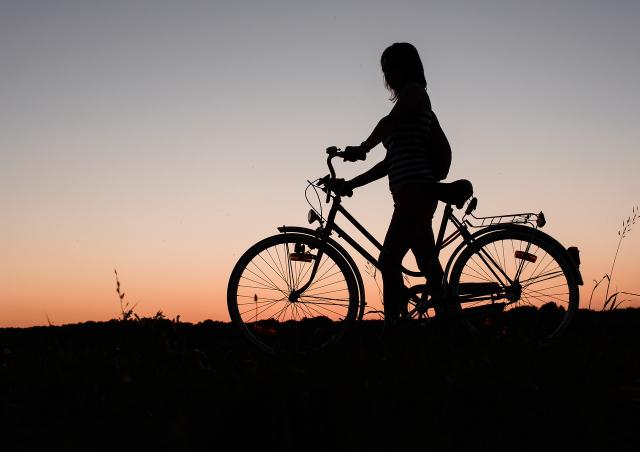Sometimes there’s a voice inside us that we just need to hear, writes Steve Biddulph.
Grace is so excited! She has a new bike – her first ever two-wheeler – and at age six she is ready to roll.
Her mum, Josie, has a well-thought-out plan: there is a park near their house so they wheel their bikes over there and find a nice safe bit of path.
Off Grace goes, wobbling a little but peddling flat out to stay vertical, as she’s been told.
In fact, her mum is now a bit worried about her speeding away and pedals her own bike to catch up.
There is a bend in the path coming up. She shouts, “Slow down, Grace,” but it’s too late. Grace takes a tumble onto the (fortunately) soft grass. Two older girls nearby look concerned, but Josie is there in a second, helping Grace dust herself off.
But Grace is in tears. She is inconsolable throughout the short walk back to their house and inside to sit on the couch.
There are a heap of things Josie can do now.
She can look at the grazed knee and kiss them better. (Worth a try).
She can offer some ice cream or lemonade as a distraction. (Comfort eating, hmm, not sure). She can put a bandaid on the graze. (Always helpful to do).
She can also get cross and question why this girl is making such a fuss. “Didn’t you hear me call out to slow down? You shouldn’t have gone so fast.” (Grace probably knows this already. The lesson was fairly self-evident).
We’ve all tried all of these strategies – sympathy, blame, distraction!
But Josie does an interesting thing. She sits right beside Grace. She talks softly.
Josie: “You took a really bad fall with your new bicycle. You were doing so well. You dared to go fast. And now you have a scraped knee and it hurts!”
Grace nods emphatically but continues to cry and sob.
Josie: “You also have to sob really badly. Can you feel inside where that bad feeling is?”
Grace points to her stomach.
Josie: “Can you sit with it in a friendly way and ask what it feels like there?”
Grace: “It is in my stomach here, really bad.” She becomes more quiet and attentive.
Josie: “It is in your stomach. How is it there in your stomach?”
Grace: “It’s all going around.” She moves her hands around.
Josie: “It just keeps going around inside.”
Grace: “… just like grabbing hands.
Josie: “Just like grabbing hands. If you keep feeling that, do those grabbing hands have a story to tell you?”
Grace, sobbing loudly now: “Yes! Those big girls should not have stood there looking like that…
I am sure they think I am a stupid little kid.”
Josie: “You hated that they were standing there looking. They are bigger. And then you are afraid that they think you are small and stupid.”
There is a pause.
Grace: “Yes!”
Josie: “Does that feeling have a colour inside? Maybe you can close your eyes for a minute and wait for what comes.”
Grace: “Yes. Red is coming and also something black.”
Josie: “Would you draw and colour it? Your hand will put everything on the sheet of paper. It doesn’t have to be beautiful. The feeling will know what it means.”
Hesitantly, Grace starts with dark colours, then the stripes get stronger and the sobbing stops.
She scratches with the crayon fiercely, adding more lines, and another colour.
There is a deep sigh. Then there are yellow and orange circles. She looks up at Josie and smiles.
Who knows what is going on in the mind of a child?
We have to help them figure out when feelings are just too strong for them to handle.
Josie did such an interesting thing – she used very explorative prompts.
She echoed the meaningful things that were emerging, just staying with the moment.
She enquired for the “message” that the feelings wanted to say, and the meaning shifted like a sudden change in the wind.
This wasn’t about a hurt knee. It was about a deep sense of humiliation. Who knows where it came from, but it doesn’t matter – it’s being healed.
These are what I call Wild Creature methods. You talk to the Wild Creature part of your mind, which knows things and has memories but talks through our body.
If a child can make friends with their Wild Creature Mind, by listening to the place inside that hurts, their fears come to the surface and are then easier to deal with.
Very often we parents don’t know what is going on inside our kids, but if we are willing to breathe deep and listen, then together you – and they – and their Wild Creature Mind, can team up and figure it out.
Steve Biddulph is the author of Raising Girls, Raising Boys, and Manhood.
His new book Make Friends With Your Wild Creature Mind will be out from Pan MacMillan in September.
Grace’s story is from the new book and is used courtesy of Dutch authors Marta Stapert and Erik Verliefte.







